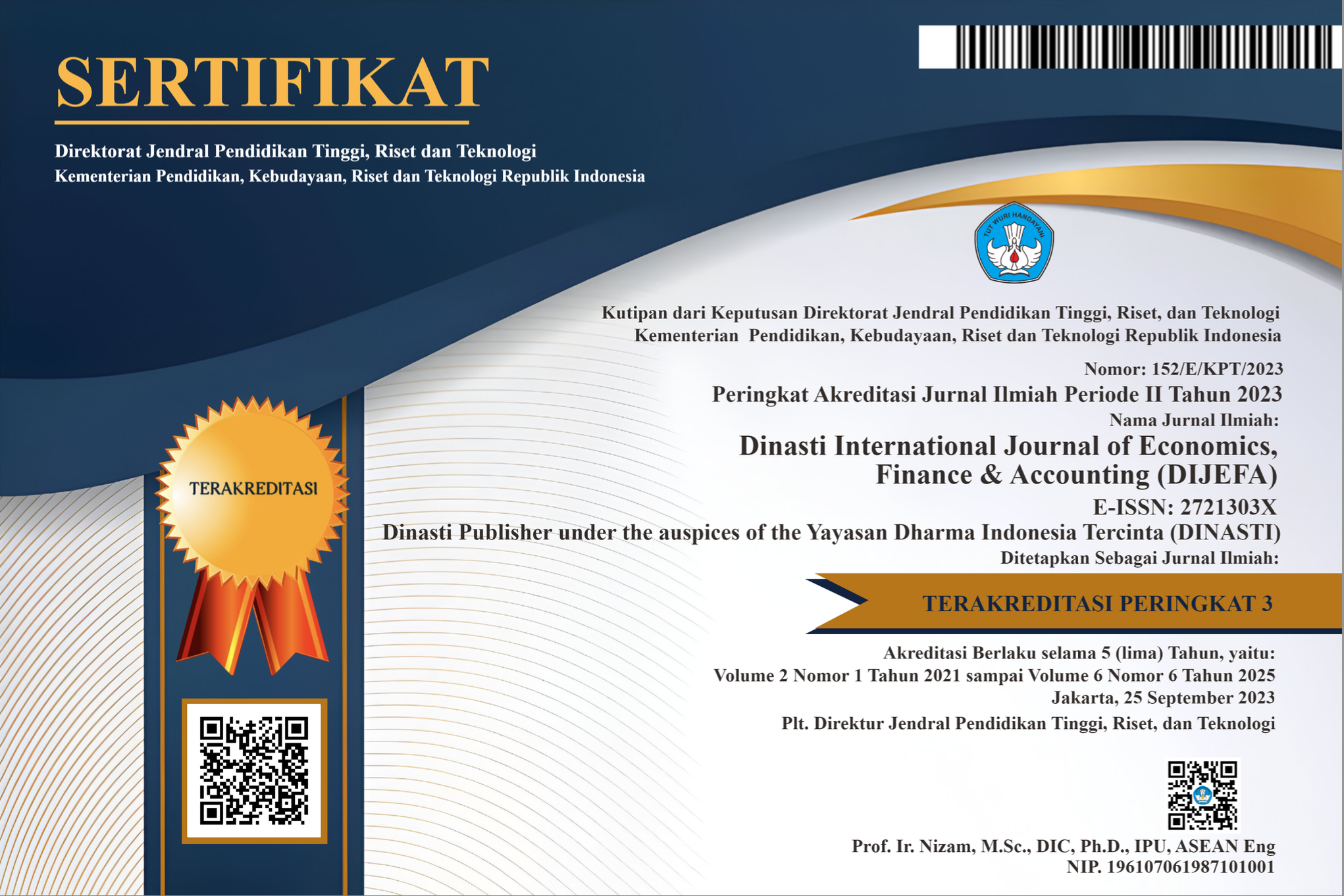Consumption Value Dimension of Green Purchase Intention with Green Trust as Mediating Variable
DOI:
https://doi.org/10.38035/dijefa.v3i3.1392Keywords:
Social Value, Emotional Value, Green Purchase Intention, Functional Value, Green TrustAbstract
One of the sectors that pollute the environment is the cosmetics sector. Pay close attention to the packaging and microplastic waste that have been produced. Presently, the cosmetics company Garnier create a Garnier Green Beauty campaign to transform the company and lessen its impact on the environment. Garnier is working to produce cosmetics with more environmentally friendly formulae. By decreasing waste, it will be possible to reduce plastic pollution. This study examines what influences someone to use eco-friendly beauty products and be willing to purchase Garnier products. Quantitative research techniques were used in this investigation. 211 respondents fit the criteria for knowing about Garnier products but had never used them. The results of the study show that the intentions of consumers to make green purchases are significantly influenced by the functional value, social value, and emotional worth of various goods. However, social work has little impact on green trust.
References
Alifah, N. (2021). Pandemi dan Meningkatnya Sampah Plastik - EcoNusa. https://econusa.id/id/ecoblog/pandemi-dan-meningkatnya-sampah-plastik/. [Agustus 2, 2022]
Amin, S., & Tarun, M. T. (2021). Effect of consumption values on customers’ green purchase intention: a mediating role of green trust. Social Responsibility Journal, 17(8), 1320–1336. https://doi.org/10.1108/SRJ-05-2020-0191
Carrete, L., Castaño, R., Felix, R., Centeno, E., & González, E. (2012). Green consumer behavior in an emerging economy: Confusion, credibility, and compatibility. Journal of Consumer Marketing, 29(7), 470–481. https://doi.org/10.1108/07363761211274983
Chairy, C., & Alam, M. E. N. (2019). The Influence of Environmental Concern, Green Perceived Knowledge, and Green Trust on Green Purchase Intention. Jurnal Manajemen, 10(2), 131. https://doi.org/10.32832/jm-uika.v10i2.2431
Chan, R. Y. K. (2001). MAR WILEJ RIGHT INTERACTIVE Base of text Top of CT Base of DF Determinants of Chinese Consumers’ Green Purchase Behavior. In Psychology & Marketing (Vol. 18, Issue 4). John Wiley & Sons, Inc.
Chen, Y. S. (2009). The Drivers of Green Brand Equity: Green Brand Image, Green Satisfaction, and Green Trust. Journal of Business Ethics 2009 93:2, 93(2), 307–319. https://doi.org/10.1007/S10551-009-0223-9
Fernández-Manzanal, R., Rodríguez-Barreiro, L., & Carrasquer, J. (2007). Evaluation of environmental attitudes: Analysis and results of a scale applied to university students. Science Education, 91(6), 988–1009. https://doi.org/10.1002/sce.20218
Garnier, S. (2020). Laporan Kemajuan Berkelanjutan.
Ghozali, I. (2013). Aplikasi Analisis Multivariate Dengan Program SPSS. Badan Penerbit Universitas Dipenogoro.
Grunert, K. G., Perrea, T., Zhou, Y., Huang, G., Sørensen, B. T., & Krystallis, A. (2011). Is food-related lifestyle (FRL) able to reveal food consumption patterns in non-Western cultural environments? Its adaptation and application in urban China. Appetite, 56(2), 357–367. https://doi.org/10.1016/j.appet.2010.12.020
Gupta, S., & Ogden, D. T. (2009). To buy or not to buy? A social dilemma perspective on green buying. Journal of Consumer Marketing, 26(6), 378–393. https://doi.org/10.1108/07363760910988201
Hair, J. F., Black, W. C., Babin, B. J., & Anderson, R. E. (2014). Multivariate Data Analysis (7th ed.).
Haryono, S. (2016). Metode SEM Untuk Penelitian Manajemen dengan AMOS LISREL PLS. PT. Intermedia Personalia Utama.
Hedlund, T. (2011). The impact of values, environmental concern, and willingness to accept economic sacrifices to protect the environment on tourists’ intentions to buy ecologically sustainable tourism alternatives. Tourism and Hospitality Research, 11(4), 278–288. https://doi.org/10.1177/1467358411423330
Jamal, A. (2021). MMS Marketing Management Studies Dimensions of Consumption Value of Green Repurchase Intention with Green Trust as an Intervening Variable. https://doi.org/10.24036/jkmp.v1i1
Jamrozy, U., & Lawonk, K. (2017). The multiple dimensions of consumption values in ecotourism. International Journal of Culture, Tourism, and Hospitality Research, 11(1), 18–34. https://doi.org/10.1108/IJCTHR-09-2015-0114
Johnstone, M. L., & Tan, L. P. (2015). An exploration of environmentally-conscious consumers and the reasons why they do not buy green products. Marketing Intelligence and Planning, 33(5), 804–825. https://doi.org/10.1108/MIP-09-2013-0159
Khalid, H. (2020). Sampah Domestik Jadi Permasalahan Utama di Indonesia - Indonesia Environment & Energy Center. https://environment-indonesia.com/sampah-domestik-jadi-permasalahan-utama-di-indonesia/. [Agustus 2, 2022]
Kompas. (2020). Merawat Keindahan Bumi, Garnier Luncurkan Program Green Beauty. https://biz.kompas.com/read/2020/12/20/144213828/merawat-keindahan-bumi-garnier-luncurkan-program-green-beauty. [Agustus 2, 2022]
Lu, L. Y. Y., Wu, C. H., & Kuo, T. C. (2007). Environmental principles apply to green supplier evaluation by using multi-objective decision analysis. International Journal of Production Research, 45(18–19), 4317–4331. https://doi.org/10.1080/00207540701472694
Minhal, S. M., Zaidi, R., Yifei, L., Bhutto, M. Y., Ali, R., & Alam, F. (2019). The Influence of Consumption Values on Green Purchase Intention: A Moderated Mediation of Greenwash Perceptions and Green Trust. In Pakistan Journal of Commerce and Social Sciences (Vol. 13, Issue 4). https://ssrn.com/abstract=3522451
Nik, N. R., & Rashid, A. (2009). Awareness of Eco-label in Malaysia’s Green Marketing Initiative. In International Journal of Business and Management (Vol. 4, Issue 8).
Novelino, A. (2022). Sampah Plastik 2021 Naik ke 11,6 Juta Ton, KLHK Sindir Belanja Online. https://www.cnnindonesia.com/nasional/20220225173203-20-764215/sampah-plastik-2021-naik-ke-116-juta-ton-klhk-sindir-belanja-online
Nugraheni, N. . (2021). 5 Negara ini Penyumbang Sampah Plastik Terbesar di Dunia, Indonesia Urutan Ke-3. https://tekno.tempo.co/read/1521617/5- negara-ini-penyumbang-sampah-plastik-terbesar-di-dunia-indonesia-urutanke-3
Putri, A. W. (2019). Limbah Plastik Produk-produk Kecantikan yang Tak Kalah Berbahaya. https://tirto.id/limbah-plastik-produk-produk-kecantikan-yang-tak-kalah-berbahaya-efmA. [Agustus 2, 2022]
Rayne, L. (2013). Conscious spending, conscious life : an uncommon guide to navigating the consumer culture. 386.
Sánchez-Fernández, R., & Iniesta-Bonillo, M. Á. (2007). The concept of perceived value: A systematic review of the research. Marketing Theory, 7(4), 427–451. https://doi.org/10.1177/1470593107083165
Sekaran, U., & Bougie, R. (2016). Research Method for Business : A Skill-Building Approach (Vol. 4, Issue 1). Wiley Publishing, Inc.
Sheth, J. N., Newman, B. I., & Gross, B. L. (1991). Why we buy what we buy: A theory of consumption values. Journal of Business Research, 22(2), 159–170. https://doi.org/10.1016/0148-2963(91)90050-8
Situmorang, H. D. (2021). 4,8 Juta Ton per Tahun Sampah Plastik di Indonesia Tidak Dikelola dengan Baik. https://www.beritasatu.com/nasional/792091/48-juta-ton-per-tahun-sampahplastik-di-indonesia-tidak-dikelola-dengan-baik. [Agustus 2, 2022]
Sweeney, J. C., & Soutar, G. N. (2001). Consumer perceived value: The development of a multiple item scale. Journal of Retailing, 77(2), 203–220. https://doi.org/10.1016/S0022-4359(01)00041-0
Thøgersen, J., de Barcellos, M. D., Perin, M. G., & Zhou, Y. (2015). Consumer buying motives and attitudes towards organic food in two emerging markets: China and Brazil. International Marketing Review, 32(3–4), 389–413. https://doi.org/10.1108/IMR-06-2013-0123/FULL/XML
Vergragt, P., Akenji, L., & Dewick, P. (2014). Sustainable production, consumption, and livelihoods: global and regional research perspectives. Journal of Cleaner Production, 63, 1–12. https://doi.org/10.1016/J.JCLEPRO.2013.09.028
Vermeir, I., & Verbeke, W. (2008). Sustainable food consumption among young adults in Belgium: Theory of planned behavior and the role of confidence and values. Ecological Economics, 64(3), 542–553. https://doi.org/10.1016/J.ECOLECON.2007.03.007
Wong, K. H., Chang, H. H., & Yeh, C. H. (2019). The effects of consumption values and relational benefits on smartphone brand switching behavior. Information Technology and People, 32(1), 217–243. https://doi.org/10.1108/ITP-02-2018-0064Alifah, N. (2021). Pandemi dan Meningkatnya Sampah Plastik - EcoNusa. https://econusa.id/id/ecoblog/pandemi-dan-meningkatnya-sampah-plastik/. [Agustus 2, 2022]
Amin, S., & Tarun, M. T. (2021). Effect of consumption values on customers’ green purchase intention: a mediating role of green trust. Social Responsibility Journal, 17(8), 1320–1336. https://doi.org/10.1108/SRJ-05-2020-0191
Carrete, L., Castaño, R., Felix, R., Centeno, E., & González, E. (2012). Green consumer behavior in an emerging economy: Confusion, credibility, and compatibility. Journal of Consumer Marketing, 29(7), 470–481. https://doi.org/10.1108/07363761211274983
Chairy, C., & Alam, M. E. N. (2019). The Influence of Environmental Concern, Green Perceived Knowledge, and Green Trust on Green Purchase Intention. Jurnal Manajemen, 10(2), 131. https://doi.org/10.32832/jm-uika.v10i2.2431
Chan, R. Y. K. (2001). MAR WILEJ RIGHT INTERACTIVE Base of text Top of CT Base of DF Determinants of Chinese Consumers’ Green Purchase Behavior. In Psychology & Marketing (Vol. 18, Issue 4). John Wiley & Sons, Inc.
Chen, Y. S. (2009). The Drivers of Green Brand Equity: Green Brand Image, Green Satisfaction, and Green Trust. Journal of Business Ethics 2009 93:2, 93(2), 307–319. https://doi.org/10.1007/S10551-009-0223-9
Fernández-Manzanal, R., Rodríguez-Barreiro, L., & Carrasquer, J. (2007). Evaluation of environmental attitudes: Analysis and results of a scale applied to university students. Science Education, 91(6), 988–1009. https://doi.org/10.1002/sce.20218
Garnier, S. (2020). Laporan Kemajuan Berkelanjutan.
Ghozali, I. (2013). Aplikasi Analisis Multivariate Dengan Program SPSS. Badan Penerbit Universitas Dipenogoro.
Grunert, K. G., Perrea, T., Zhou, Y., Huang, G., Sørensen, B. T., & Krystallis, A. (2011). Is food-related lifestyle (FRL) able to reveal food consumption patterns in non-Western cultural environments? Its adaptation and application in urban China. Appetite, 56(2), 357–367. https://doi.org/10.1016/j.appet.2010.12.020
Gupta, S., & Ogden, D. T. (2009). To buy or not to buy? A social dilemma perspective on green buying. Journal of Consumer Marketing, 26(6), 378–393. https://doi.org/10.1108/07363760910988201
Hair, J. F., Black, W. C., Babin, B. J., & Anderson, R. E. (2014). Multivariate Data Analysis (7th ed.).
Haryono, S. (2016). Metode SEM Untuk Penelitian Manajemen dengan AMOS LISREL PLS. PT. Intermedia Personalia Utama.
Hedlund, T. (2011). The impact of values, environmental concern, and willingness to accept economic sacrifices to protect the environment on tourists’ intentions to buy ecologically sustainable tourism alternatives. Tourism and Hospitality Research, 11(4), 278–288. https://doi.org/10.1177/1467358411423330
Jamal, A. (2021). MMS Marketing Management Studies Dimensions of Consumption Value of Green Repurchase Intention with Green Trust as an Intervening Variable. https://doi.org/10.24036/jkmp.v1i1
Jamrozy, U., & Lawonk, K. (2017). The multiple dimensions of consumption values in ecotourism. International Journal of Culture, Tourism, and Hospitality Research, 11(1), 18–34. https://doi.org/10.1108/IJCTHR-09-2015-0114
Johnstone, M. L., & Tan, L. P. (2015). An exploration of environmentally-conscious consumers and the reasons why they do not buy green products. Marketing Intelligence and Planning, 33(5), 804–825. https://doi.org/10.1108/MIP-09-2013-0159
Khalid, H. (2020). Sampah Domestik Jadi Permasalahan Utama di Indonesia - Indonesia Environment & Energy Center. https://environment-indonesia.com/sampah-domestik-jadi-permasalahan-utama-di-indonesia/. [Agustus 2, 2022]
Kompas. (2020). Merawat Keindahan Bumi, Garnier Luncurkan Program Green Beauty. https://biz.kompas.com/read/2020/12/20/144213828/merawat-keindahan-bumi-garnier-luncurkan-program-green-beauty. [Agustus 2, 2022]
Lu, L. Y. Y., Wu, C. H., & Kuo, T. C. (2007). Environmental principles apply to green supplier evaluation by using multi-objective decision analysis. International Journal of Production Research, 45(18–19), 4317–4331. https://doi.org/10.1080/00207540701472694
Minhal, S. M., Zaidi, R., Yifei, L., Bhutto, M. Y., Ali, R., & Alam, F. (2019). The Influence of Consumption Values on Green Purchase Intention: A Moderated Mediation of Greenwash Perceptions and Green Trust. In Pakistan Journal of Commerce and Social Sciences (Vol. 13, Issue 4). https://ssrn.com/abstract=3522451
Nik, N. R., & Rashid, A. (2009). Awareness of Eco-label in Malaysia’s Green Marketing Initiative. In International Journal of Business and Management (Vol. 4, Issue 8).
Novelino, A. (2022). Sampah Plastik 2021 Naik ke 11,6 Juta Ton, KLHK Sindir Belanja Online. https://www.cnnindonesia.com/nasional/20220225173203-20-764215/sampah-plastik-2021-naik-ke-116-juta-ton-klhk-sindir-belanja-online
Nugraheni, N. . (2021). 5 Negara ini Penyumbang Sampah Plastik Terbesar di Dunia, Indonesia Urutan Ke-3. https://tekno.tempo.co/read/1521617/5- negara-ini-penyumbang-sampah-plastik-terbesar-di-dunia-indonesia-urutanke-3
Putri, A. W. (2019). Limbah Plastik Produk-produk Kecantikan yang Tak Kalah Berbahaya. https://tirto.id/limbah-plastik-produk-produk-kecantikan-yang-tak-kalah-berbahaya-efmA. [Agustus 2, 2022]
Rayne, L. (2013). Conscious spending, conscious life : an uncommon guide to navigating the consumer culture. 386.
Sánchez-Fernández, R., & Iniesta-Bonillo, M. Á. (2007). The concept of perceived value: A systematic review of the research. Marketing Theory, 7(4), 427–451. https://doi.org/10.1177/1470593107083165
Sekaran, U., & Bougie, R. (2016). Research Method for Business : A Skill-Building Approach (Vol. 4, Issue 1). Wiley Publishing, Inc.
Sheth, J. N., Newman, B. I., & Gross, B. L. (1991). Why we buy what we buy: A theory of consumption values. Journal of Business Research, 22(2), 159–170. https://doi.org/10.1016/0148-2963(91)90050-8
Situmorang, H. D. (2021). 4,8 Juta Ton per Tahun Sampah Plastik di Indonesia Tidak Dikelola dengan Baik. https://www.beritasatu.com/nasional/792091/48-juta-ton-per-tahun-sampahplastik-di-indonesia-tidak-dikelola-dengan-baik. [Agustus 2, 2022]
Sweeney, J. C., & Soutar, G. N. (2001). Consumer perceived value: The development of a multiple item scale. Journal of Retailing, 77(2), 203–220. https://doi.org/10.1016/S0022-4359(01)00041-0
Thøgersen, J., de Barcellos, M. D., Perin, M. G., & Zhou, Y. (2015). Consumer buying motives and attitudes towards organic food in two emerging markets: China and Brazil. International Marketing Review, 32(3–4), 389–413. https://doi.org/10.1108/IMR-06-2013-0123/FULL/XML
Vergragt, P., Akenji, L., & Dewick, P. (2014). Sustainable production, consumption, and livelihoods: global and regional research perspectives. Journal of Cleaner Production, 63, 1–12. https://doi.org/10.1016/J.JCLEPRO.2013.09.028
Vermeir, I., & Verbeke, W. (2008). Sustainable food consumption among young adults in Belgium: Theory of planned behavior and the role of confidence and values. Ecological Economics, 64(3), 542–553. https://doi.org/10.1016/J.ECOLECON.2007.03.007
Wong, K. H., Chang, H. H., & Yeh, C. H. (2019). The effects of consumption values and relational benefits on smartphone brand switching behavior. Information Technology and People, 32(1), 217–243. https://doi.org/10.1108/ITP-02-2018-0064
Downloads
Published
How to Cite
Issue
Section
License
Authors who publish their manuscripts in this journal agree to the following conditions:
- The copyright on each article belongs to the author(s).
- The author acknowledges that the Dinasti International Journal of Economics, Finance & Accounting (DIJEFA) has the right to be the first to publish with a Creative Commons Attribution 4.0 International license (Attribution 4.0 International (CC BY 4.0).
- Authors can submit articles separately, arrange for the non-exclusive distribution of manuscripts that have been published in this journal into other versions (e.g., sent to the author's institutional repository, publication into books, etc.), by acknowledging that the manuscript has been published for the first time in the Dinasti International Journal of Economics, Finance & Accounting (DIJEFA).


























































